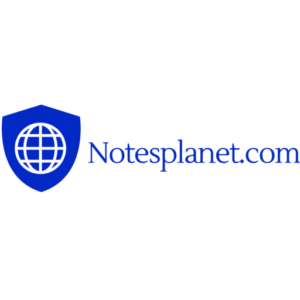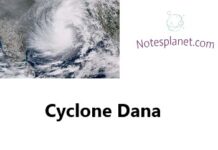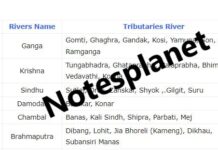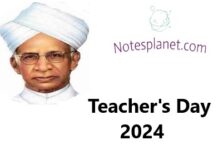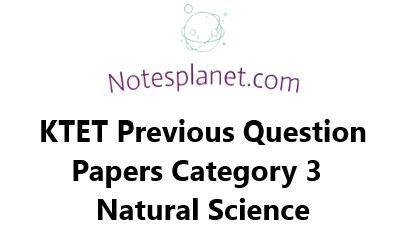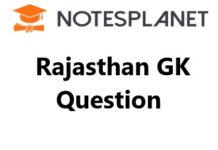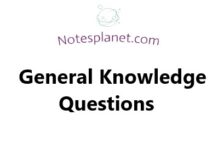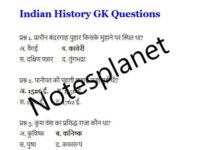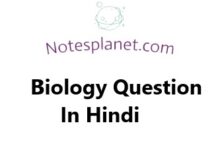KTET Previous Question Papers
KTET Previous Question Papers Category Three Natural Science: Aspiring teachers can use the KTET Category 3 Natural Science paper to demonstrate their scientific knowledge and teaching skills.
Previous Question Papers Category 3 Natural Science
Ques 1. Which one of the following is not related to homologous organs?
(A) Doing similar functions
(B) Similar in anatomy
(C) Inherited from a common ancestor
(D) Similar developmental pattern
Ques 2. In C2, plants, CO2, fixation initially results in the formation of:
(A) Malic acid
(8) OAA
(C) PEP
(D) PGA
Ques 3. One of the following characters can be represented by floral formula but not by floral diagram.
(A) Position of gynoecium
(B) Aestivation
(C) Placentation
(D) Fusion of stamens
Ques 4. GEAC stands for:
(A) Genetic Engineering Approval Committee
(B) Genome Engineering Action Committee
(C) Genetic and Engineering Approval Council
(D) Global Environmental Action Council
Ques 5. Father of biodiversity is:
(A) Edward O. Wilson
(B) Ernst Haeckel-
(C) Karl Ereky
(D) Charles Elton
Ques 6. Southern hybridization technique is used for the analysis of chromosomal DNA. One among the following is NOT involved in this technique. It is
(A) Autoradiography
(B) Electrophoresis
(C) PCR-
(D) Blotting
Ques 7. Which one of the following is not a variety of cattle?
(A) Gir
(B) Sahiwal
(C) Vechoor
(D) Ancona
Ques 8. Tumors arising from cells in connective tissue, bone or muscle are called:
(A) Sarcoma
(B) Carcinoma
(C) Lymphoma
(D) Myeloma
Ques 9. The region in which the DNA is wrapped around a cluster of histone proteins is called:
(A) Nucleosome
(B) Mesosome
(C) Desmosome
(D) Centrosome
Ques 10. When there is no consumption of oxygen in respiration, the respiratory quotient will be?
(A) 0.9
(B) 1
(C) 3
(D) infinity
KTET Previous Question Papers
Ques 11. Human Y chromosome is
(A) Telocentric
(B) Metacentric
(C) Submetacentric
(D) Acrocentric
Ques 12. A hyperglycemic hormone is :
(A) Thymosin
(B) Insulin
(C) Glucagon
(D) Vasopressin
Ques 13. An example of loose connective tissue is:
(A) Cartilage
(B) Adipose tissue
(C) Tendon
(D) Blood
Ques 14. Natality, a characteristic of population refers to:
(A) The increase in number of individuals in a population during a given period.
(B) Total number of individuals present per unit area at a given time.
(C) The number of individuals that have come into the habitat during a given period.
(D) The maximum number of individuals of a population that can be sustained indefinitely in a given habitat.
Ques 15. 70S ribosomes are seen in:
(A) Bacteria, Centriole, Chloroplast
(B) Chloroplast, Centriole, Mitochondria
(C) Centriole, Mitochondria, Bacteria
(D) Bacteria, Mitochondria, Chloropla
Ques 16. Double fertilisation, a unique feature angiosperms was first observed by:
(A) Camerarius
(B) Hofmeister
(C) S.G. Nawaschin
(D) Strasburger
Ques 17. The largest salivary gland is:
(A) Sublingual
(B) Sub-maxillary
(C) Parotid
(D) Submandibular
Ques 18. Programmed cell death is called:
(A) Plasmolysis
(B) Necrosis
(C) Apoptosis
(D) Punalvicie
Ques 19. One of the following is a carotenoid derivative. Which is that?
(A) ABAT
(B) IAA
(C) GA
(D) IBA
Ques 20. Dachigam National Park is in:
(A) Himachal Pradesh
(B) Uttarakhand
(C) Kashmir
(D) Rajasthan
Important Links
Facebook: Notesplanet
Instagram: Notesplanet1
Youtube: Notesplanet
Tags: Ktet previous question papers category 3 natural science with answers, Ktet previous question papers category 3 natural science pdf download, Ktet previous question papers category 3 natural science pdf, KTET Category 3 Natural Science Question Paper with answers, KTET Category 3 Natural Science questions and answers PDF, Ktet previous question papers category 3 natural science 2021, KTET Category 3 Question Paper with answers PDF download, KTET Category 3 Hindi Question Paper with answers.
